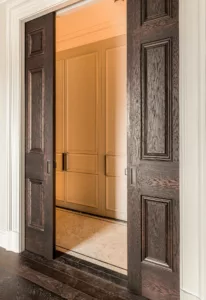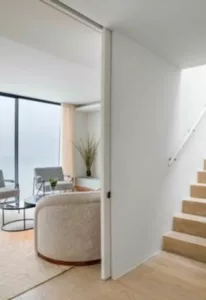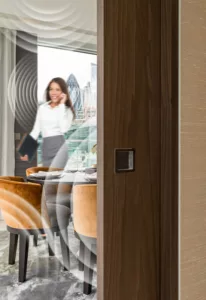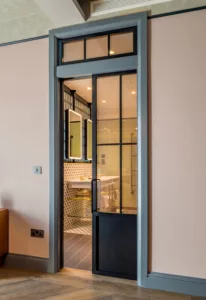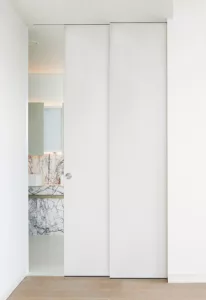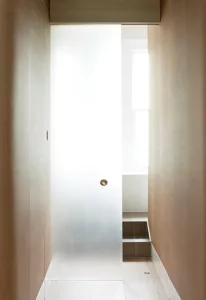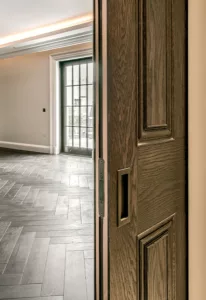Why Enigma Pocket Doors Have Market Leading Reliability, Durability and Aesthetics

Enigma Pocket Doors have been designed to provide market-leading durability and reliability. We know the legacy issues associated with pocket doors, so it is essential achieve the strongest and best performing pocket doors on the market.
Read below to find out more about each of the components that make our pocket doors and why there were chosen. We’re confident that you will be confident in the reliability and durability of our Enigma Pocket Doors.
Aluminium Pocket System
The Enigma pocket system is made up of the base channel, head channel, leading edge jambs and intermediate jamb. The Enigma pocket system is made of aluminium to provide maximum strength with minimal space. One of the most common problems is their performance over time, with many users finding their sliding door does not run in and out of the pocket smoothly. This is often caused by weak sidewalls which jam with the drywall and scratch the door.
We also chose aluminium to make our pocket doors last the lifetime of a building. Timber frames deteriorate and if steel has been bent, it will remain that shape, whereas aluminium will always return back to its original state and thus maintaining the structure of the pocket system.
The strength of the sidewall is critical and is often where pocket doors go wrong, as there is little space, for it to flex without hitting the door. From a design perspective, the wall thickness is a standard wall (120mm or 145mm) and with a 44mm door and a gap either side before you have the side wall. This leaves little room for the door within the pocket, which can lead to performance issues or damage to the door as it slides. This is why we developed the Enigma pocket system with extruded box section aluminium. To achieve maximum strength from minimum wall thickness. It’s light weight to carry around site but has been extruded with cross sections to increase its strength. On-site, you can cut with a normal chop saw which means the frames and pocket system can be adjusted to suit your specific opening size. The aluminium is ribbed either side of the timber insert, in case the screw hits the aluminium instead of the timber, which helps grip the screws to pull in straight.
Recyclable Pocket Packers
Our pocket packers are supplied to our customers free of charge, and they are recyclable. The pocket packers are incredibly useful as they slide into the pocket and will hold it straight whilst the installer is fitting the drywall to the side studs. This prevents the previously mentioned issues experienced with bowed side walls.
Sliding Track and Gear Set
One of the main features that sets Enigma Pocket Doors apart is the sliding track. We recently launched our Mark II running gear which is made from aluminium trolley and actual roller wheels to provide an even more durable pocket door system that maintains its performance over time.
Pocket doors are prone to rumbling and performance deteriorating over time which is caused when the pocket door sits in one place for a long period of time. This creates a flat on the bottom of the wheel and can cause the rumbling sound when moved. Enigma Pocket Door wheels have been designed to be durable enough to stand the test of time and can carry more weight. To prove the durability of our pocket doors, not only have we tested to 100,000 open close cycles, but to test their resilience on-site and in high-traffic areas, we have also dropped our running gear from up to 10 metres high and there was no damage. Check out the video here!
Ball bearing vs needle bearing
Traditional pocket doors used a ball bearing system which often shift in position because they are not complete in the channel around the wheel. This can cause uneven weight distribution and lead to damage of the wheel.
Enigma Pocket Doors use a needle bearing system which holds the lubricant in, and the needle system provides a more even weight distribution around the axel. The lubrication improves the performance and the needle bearing increases the longevity of the pocket door.
Moveable Remote Stop
The remote stop slots into the groove at the top of the track and allows the installer to create a stop for where they want the door to stop. As the remote stop sits within the pocket, this can be adjusted at any time without removing the side wall. This design was created to make the life of installers easier, as if the door sits a few millimetres too proud once installed or recessed, the remote stop can easily be adjusted from the back of the pocket all the way to the opening itself to ensure the door fits flush. This can all be done quickly from the opening from an installer on-site.
The remote stop is one of the many features designed from feedback from installers to make the system quick and easy to install. Normal installation of pocket can take one to two hours; Enigma Pocket doors can be done in half that time.
Self-Supporting Head for High Rise Projects
Our self-supporting head is designed specifically for our pocket doors used in high rise residential and commercial buildings, where fixing the structure to both the bottom and head slap is prohibited. The Enigma self-supporting head allows the kit to be fitted into the bottom slab which crates a goal post opening for the stud to be fixed into the head channel without fixing to the top slab. The self-supporting head is available for a range of sizes but has also been carefully designed to be as compact as possible, to avoid colliding with any other structures or pipework within the wall.
Conclusion
At Selo, we exist to simplify bespoke and complex building methods and our investment into research and development, customer feedback and the quality of our materials is evident in the performance of our products.
Pocket doors provide a contemporary space saving alternative to swing doors, however, architects have previously avoided specifying pocket doors due to their high-maintenance and problems over time.
Now you can use them with peace of mind, that the Enigma Pocket Doors have been designed to last and perform for the lifetime of a building. Speak to our specification support team today to find out more.

